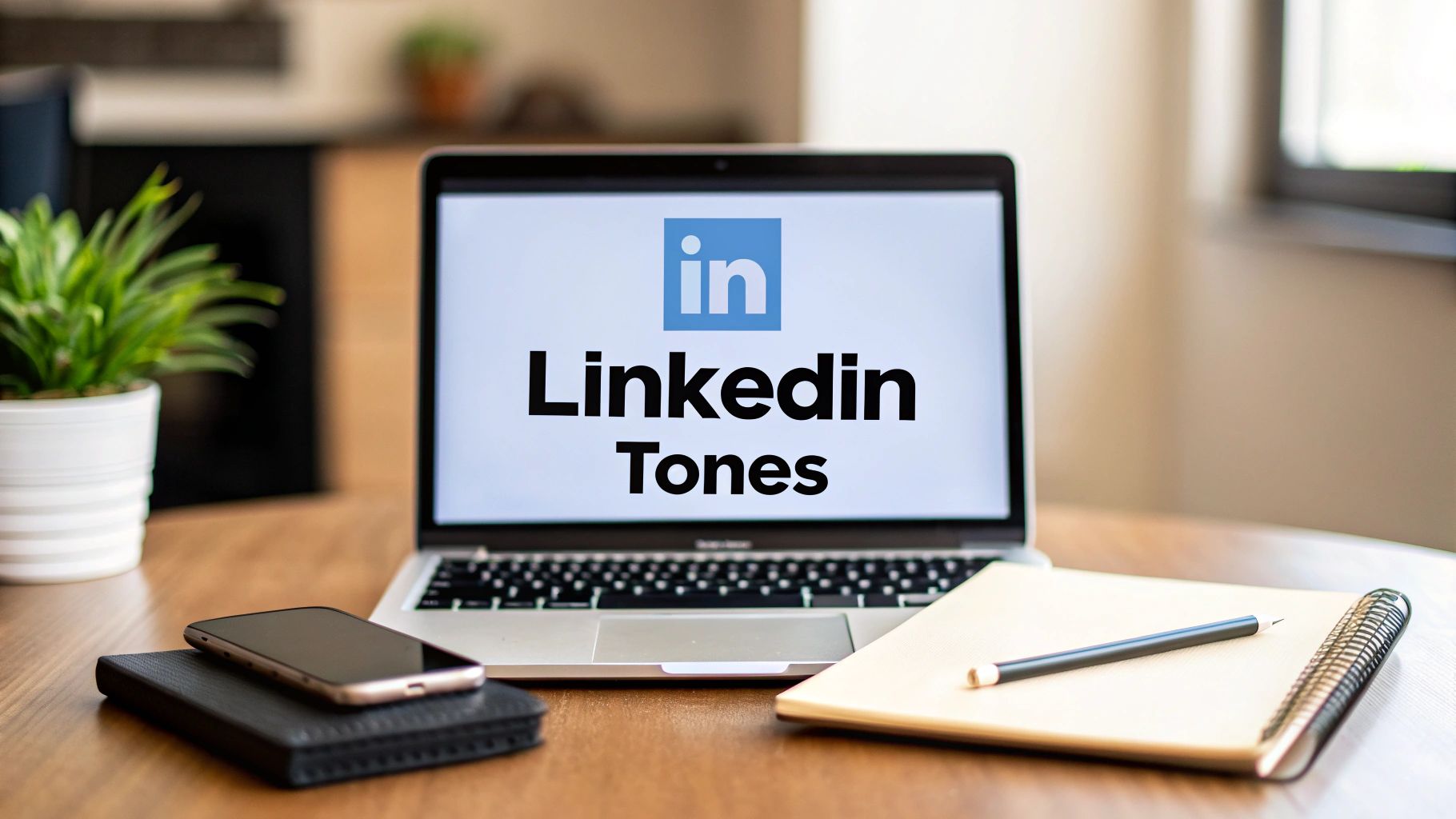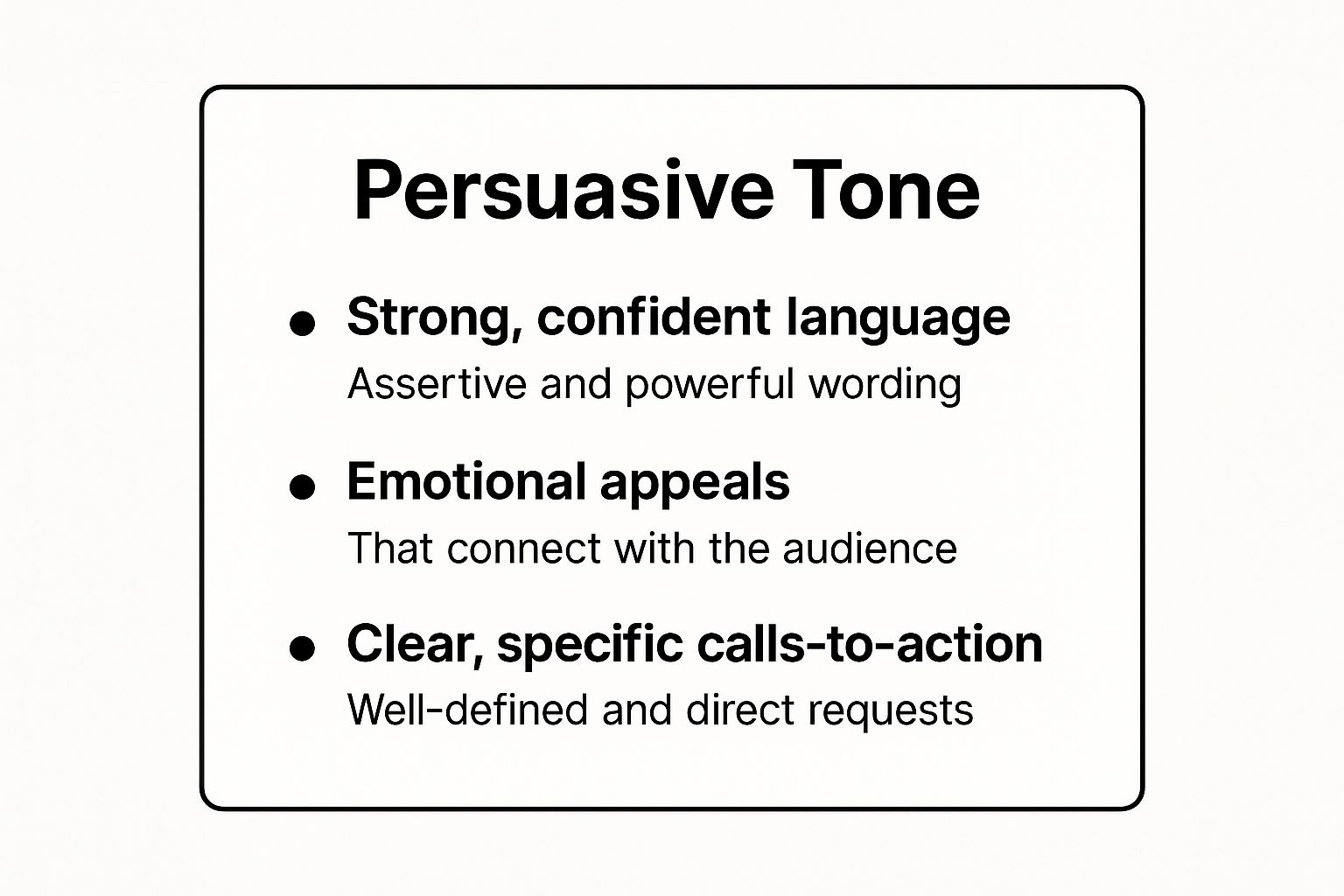
8 Essential Types of Tones to Master for LinkedIn in 2025
Published on 2025-09-26
In the crowded world of LinkedIn, what you say is only half the battle. How you say it makes all the difference. Your tone of voice is the invisible force that builds trust, establishes authority, and creates genuine connections with your professional network. It’s the difference between a post that gets scrolled past and one that stops a reader in their tracks, sparking a conversation or driving a click.
Choosing the right tone isn't about being inauthentic; it's about being strategic. A consistent voice is key to brand recognition. To ensure your tone consistently acts as your secret weapon across all platforms, establishing strong social media brand guidelines is essential. These guidelines define and maintain your brand's unique voice and personality.
This guide breaks down the 8 essential types of tones you can deploy to make your LinkedIn content more effective, memorable, and engaging. We'll explore exactly how to use each one, from formal and authoritative to empathetic and even humorous. You’ll learn when to be formal, how to be persuasive without being pushy, and why a little humor can go a long way in humanizing your professional brand. Let's dive in and find the right voice for your next big post.
1. Formal Tone
A formal tone is precise, professional, and objective. It establishes authority and credibility by using structured language, correct grammar, and a serious approach. This tone creates a respectful distance between the writer and the audience, making it ideal for situations where clarity, expertise, and professionalism are paramount. Unlike casual communication, it avoids slang, contractions, and overly personal anecdotes. Among the different types of tones, the formal one is a cornerstone of professional and academic communication.

When to Use a Formal Tone on LinkedIn
A formal tone is most effective when your goal is to convey authority, share critical information, or communicate with a traditional corporate audience. It builds trust and demonstrates a high level of professionalism.
- Sharing Research or Data: Use a formal tone when presenting industry-specific data, research findings, or in-depth analysis. This shows you have done your due diligence and are presenting factual, reliable information.
- Official Company Announcements: For major announcements like mergers, acquisitions, leadership changes, or annual financial reports, a formal tone ensures the message is delivered with the appropriate gravity and clarity.
- Addressing Serious Topics: When discussing complex legal, financial, or regulatory matters, a formal approach is essential to avoid misinterpretation and maintain credibility.
How to Implement a Formal Tone
Adopting a formal tone requires careful word choice and sentence structure. The focus is on precision and objectivity.
LinkedIn Post Example:
"Our Q3 financial analysis indicates a 15% year-over-year revenue growth, primarily driven by strategic expansion into emerging markets. This performance exceeds initial forecasts and is attributable to the successful implementation of our revised marketing strategy. A comprehensive report detailing these results will be made available to stakeholders on November 1st. We anticipate this positive trajectory will continue through the final quarter."
This example uses complete sentences, specific terminology ("year-over-year revenue growth," "emerging markets"), and maintains an objective, third-person perspective. It presents information clearly and professionally, reinforcing the company's competence and success.
2. Conversational Tone
A conversational tone mimics natural speech, creating a one-on-one dialogue between the writer and the reader. It uses everyday language, contractions, and personal pronouns like "you" and "I" to build a friendly, approachable atmosphere. This tone makes complex information more accessible and engaging, helping to forge a genuine connection with your audience. Among the different types of tones, a conversational one is excellent for building relationships and community.

When to Use a Conversational Tone on LinkedIn
A conversational tone works best when your goal is to build community, share personal insights, or make your brand feel more human. It breaks down barriers and encourages interaction, making your content more relatable.
- Sharing Personal Stories or Lessons: When posting about a personal career journey, a lesson learned, or a behind-the-scenes look at your work, a conversational style makes the story feel authentic and relatable.
- Engaging with Your Network: Use this tone when asking questions, starting discussions, or responding to comments. It encourages others to join the conversation and share their own perspectives.
- Explaining Complex Topics Simply: If you are breaking down a complicated industry concept for a broader audience, a conversational approach makes the information less intimidating and easier to digest.
How to Implement a Conversational Tone
Adopting a conversational tone means writing as if you were speaking directly to a friend or colleague. It’s about being clear, direct, and personable while maintaining professionalism.
LinkedIn Post Example:
"Ever feel like you're stuck in a creative rut? It happens to the best of us. I've found that simply stepping away from my desk for 15 minutes to take a walk can completely reset my perspective. It's amazing what a little fresh air can do. What’s your go-to trick for breaking through a creative block? I'd love to hear your ideas in the comments!"
This example uses direct questions ("Ever feel like...?"), personal pronouns ("I've found"), and contractions ("it's," "what's") to create a friendly and engaging feel. It invites a direct response, effectively starting a dialogue rather than just broadcasting a message.
3. Persuasive Tone
A persuasive tone is crafted to influence the reader's opinions, decisions, or actions. It strategically combines logical arguments with emotional appeals, using confident language and compelling evidence to guide the audience toward a specific conclusion. This tone is not about manipulation; it's about building a convincing case that resonates with the reader's needs and desires. Among the various types of tones, a persuasive one is essential for driving engagement and conversions.
This infographic summarizes the core elements that make a persuasive tone effective.

By combining confident language, emotional connection, and a clear directive, this tone effectively motivates an audience to act.
When to Use a Persuasive Tone on LinkedIn
A persuasive tone is ideal when your primary goal is to inspire action, whether it's encouraging a connection, driving traffic to a landing page, or convincing others to adopt your viewpoint. It is particularly powerful for sales, marketing, and leadership content.
- Launching a Product or Service: Use it to highlight benefits over features, address potential customer pain points, and create a sense of urgency or exclusivity for your new offering.
- Promoting an Event or Webinar: Build excitement and demonstrate value by explaining what attendees will gain, using testimonials from past events, and including a clear registration call-to-action.
- Sharing a Strong Opinion or Vision: When you want to rally support for an idea or industry trend, a persuasive tone helps you present your argument confidently and bring others to your side.
How to Implement a Persuasive Tone
Mastering a persuasive tone involves focusing on the reader's perspective and leading them to a logical conclusion. For more strategies, you can explore various business writing tips to enhance your approach.
LinkedIn Post Example:
"Are you tired of marketing strategies that promise the world but deliver nothing? Our new framework helped a client increase their lead generation by 200% in just 60 days by focusing on one thing: authentic connection. We've compiled the exact steps into a free guide. Stop wasting your budget on what doesn't work. Download the guide now and start seeing real results this quarter."
This example uses a relatable question to hook the reader, provides social proof with a specific metric, and creates urgency with a clear call-to-action. It persuades by addressing a common frustration and offering an immediate, valuable solution.
4. Humorous Tone
A humorous tone uses wit, comedy, and lightheartedness to entertain readers while delivering a message. It makes content more memorable and shareable by using techniques like irony, wordplay, and exaggeration. This approach helps humanize a brand or individual, breaking down professional barriers to create a more relatable connection with the audience. Among the different types of tones, a humorous one can be highly effective but requires a delicate balance to maintain credibility.

When to Use a Humorous Tone on LinkedIn
A humorous tone works best when you want to stand out, showcase company culture, or make a complex topic more approachable. It’s a powerful tool for building a community and increasing engagement, as people are more likely to interact with content that makes them smile.
- Showcasing Company Culture: Use humor to share behind-the-scenes moments, celebrate team milestones, or highlight the unique personalities in your workplace. This makes your company seem like a more attractive place to work.
- Marketing a Relatable Product: If your product or service solves a common, everyday frustration, humor can be a great way to connect with your audience’s pain points in an entertaining way.
- Breaking Down Dry Topics: Injecting lighthearted wit into posts about typically dry subjects can capture attention and make the information more digestible and memorable for your followers.
How to Implement a Humorous Tone
To successfully use a humorous tone, you must understand your audience’s sense of humor and align the comedy with your brand’s voice. The key is to be clever without trying too hard.
LinkedIn Post Example:
"Our coffee machine just broke on a Monday morning. Thoughts and prayers are welcome, but a skilled technician would be better. This feels like the ultimate test of our company value: 'Resilience.' We're currently surviving on sheer willpower and leftover tea bags. Send help (and caffeine)."
This example uses a relatable, everyday office problem to create a lighthearted and human moment. It showcases the company's culture and personality through self-deprecating humor, making the brand more approachable and engaging without being unprofessional.
5. Authoritative Tone
An authoritative tone establishes expertise and credibility through confident, knowledgeable language backed by evidence and experience. It demonstrates mastery of a subject matter while maintaining respect for the reader, using definitive statements and expert insights to guide and inform. This tone is assertive but not aggressive, aiming to build trust by showcasing deep understanding. Among the different types of tones, the authoritative one is crucial for positioning yourself as a go-to expert.
When to Use an Authoritative Tone on LinkedIn
An authoritative tone is ideal when you want to establish yourself as a thought leader, provide expert guidance, or share groundbreaking insights. It positions you as a credible source of information, which is invaluable for building a professional brand.
- Publishing White Papers or Case Studies: When sharing in-depth research or a detailed case study, an authoritative tone reinforces the validity of your findings and the depth of your analysis.
- Providing Expert Commentary: Use this tone when commenting on industry trends, new regulations, or significant market shifts. It shows you have a strong, informed point of view.
- Creating Educational Content: For tutorials, guides, or professional training materials, an authoritative tone assures your audience that they are learning from a knowledgeable and reliable source.
How to Implement an Authoritative Tone
To effectively use an authoritative tone, you must project confidence grounded in facts, data, and experience. Your language should be clear, direct, and backed by evidence.
LinkedIn Post Example:
"Our latest market analysis reveals that AI integration in supply chain management is no longer optional; it's a critical driver of efficiency. Companies adopting AI-powered logistics are seeing a 30% reduction in operational costs and a 25% increase in delivery speed. The data is unequivocal. To remain competitive, leaders must prioritize this technological shift now. Our comprehensive white paper, available for download, outlines a strategic implementation framework."
This example uses definitive language ("is no longer optional," "the data is unequivocal") and backs claims with specific metrics. It confidently guides the audience toward a conclusion, establishing the author as an expert in the field.
6. Empathetic Tone
An empathetic tone builds a genuine connection by showing you understand and share the feelings of your audience. It prioritizes compassion and emotional intelligence, validating your reader's challenges and experiences. This tone moves beyond simply stating facts to create a supportive and trusting environment. By acknowledging pain points and communicating with genuine care, it makes the audience feel seen and heard. Among the various types of tones, an empathetic one is crucial for building deep, human-centered relationships.
When to Use an Empathetic Tone on LinkedIn
An empathetic tone is powerful when you need to build community, offer support, or address sensitive topics. It is highly effective for fostering loyalty and showing that your brand cares about more than just business metrics.
- Addressing Customer Pain Points: Use an empathetic tone when discussing a common industry problem or a specific challenge your audience faces. This shows you are in touch with their reality and are focused on helping them.
- Discussing Mental Health or Well-being: When sharing content related to mental health, burnout, or work-life balance, an empathetic approach is essential to create a safe, non-judgmental space for discussion.
- Responding to Negative Feedback or Crises: In customer service or crisis communication, empathy de-escalates tension and demonstrates accountability. It shows you understand the frustration and are committed to resolving the issue.
How to Implement an Empathetic Tone
Adopting an empathetic tone means leading with validation and focusing on the human element of a situation. It requires thoughtful, considerate language.
LinkedIn Post Example:
"Juggling deadlines while managing team morale can be incredibly draining. We see you, and we understand the pressure leaders are under right now. It’s not just about hitting targets; it's about supporting your people through uncertainty. Remember to take a moment for yourself today. Your team needs you, but you also need to be at your best to lead effectively. You're doing a great job in a tough situation."
This example directly acknowledges a specific struggle ("draining," "pressure") and validates the reader's feelings ("We see you"). It offers support without being prescriptive, building a strong emotional connection. For more inspiration, you can explore other successful brand voice examples that master this tone.
7. Inspirational Tone
An inspirational tone motivates and uplifts readers by focusing on possibilities, potential, and positive outcomes. It uses encouraging language, success stories, and aspirational messaging to help readers envision better futures and take action toward their goals. This tone connects with the audience on an emotional level, often using storytelling and vivid imagery to build resonance. Among the various types of tones, the inspirational one is powerful for building a community and driving personal and professional growth.
When to Use an Inspirational Tone on LinkedIn
An inspirational tone is ideal when you want to connect with your audience emotionally, encourage action, or build a supportive community. It helps position you or your brand as a source of motivation and positive change.
- Sharing Personal or Team Success Stories: Use an inspirational tone when recounting a journey of overcoming challenges. This makes success feel attainable and relatable to your audience.
- Encouraging Professional Development: When promoting a course, webinar, or new skill, an inspirational approach can motivate your network to invest in their own growth and pursue their aspirations.
- Building Team Morale: Leaders can use this tone to celebrate team achievements, recognize hard work, and articulate a compelling vision for the future, fostering a positive and driven company culture.
How to Implement an Inspirational Tone
Adopting an inspirational tone involves focusing on empowerment, using positive language, and appealing to shared values. The goal is to make your audience feel capable and motivated.
LinkedIn Post Example:
"Seven years ago, I started with nothing but an idea and a relentless belief that we could do better. The path was filled with setbacks and moments of doubt, but every 'no' fueled our determination. Today, we celebrate a milestone that once seemed impossible. To anyone chasing a dream: embrace the struggle, learn from every failure, and never lose sight of your 'why.' Your breakthrough is closer than you think."
This example uses storytelling to create an emotional connection, highlights perseverance, and ends with a direct, uplifting message. It focuses on the journey and the potential within the reader, making it a classic use of an inspirational tone.
8. Informative Tone
An informative tone prioritizes clarity, accuracy, and the comprehensive delivery of factual information. Its goal is to educate the audience, making complex topics accessible by using clear explanations, logical organization, and neutral language. This tone avoids personal bias or emotional persuasion, focusing instead on presenting data and facts objectively. Among the different types of tones, an informative one is essential for building a reputation as a knowledgeable resource.
When to Use an Informative Tone on LinkedIn
An informative tone is ideal when you want to establish yourself or your brand as a subject matter expert. It's perfect for educating your audience, explaining processes, or sharing valuable knowledge that helps your network grow professionally.
- Explaining Industry Trends: Use an informative tone to break down complex market shifts, new technologies, or recent industry news. This positions you as a go-to source for relevant updates.
- How-To Guides and Tutorials: When sharing a step-by-step guide or tutorial, an informative tone ensures the instructions are clear, easy to follow, and effective for the reader.
- Summarizing Research or Case Studies: Present the key findings from a case study or research paper in a direct, factual manner. This provides value to your audience by saving them time while delivering crucial insights.
How to Implement an Informative Tone
To adopt an informative tone, focus on structure, clarity, and credibility. Your priority is making sure the reader understands the information you are presenting without ambiguity. For more details, explore these different tones of writing.
LinkedIn Post Example:
"To improve your website's SEO, start by conducting a comprehensive keyword analysis. First, identify primary and long-tail keywords relevant to your industry using tools like Ahrefs or SEMrush. Second, map these keywords to specific pages on your site, ensuring content aligns with user intent. Finally, optimize on-page elements such as title tags, meta descriptions, and header tags with your target keywords. This structured approach helps search engines better understand and rank your content."
This example breaks down a complex process into simple, actionable steps. It uses clear, direct language and organizes the information logically, making it easy for the reader to learn and apply the advice.
Tone Style Comparison of 8 Types
| Tone | Implementation Complexity 🔄 | Resource Requirements ⚡ | Expected Outcomes 📊 | Ideal Use Cases 💡 | Key Advantages ⭐ |
|---|---|---|---|---|---|
| Formal Tone | Moderate: Requires strict grammar and structure | Moderate: Knowledge of professional conventions | High credibility and authority; professional impression | Academic writing, legal documents, corporate reports | Universal understanding; establishes authority |
| Conversational Tone | Low to Moderate: Natural language, variable sentence length | Low: Familiarity with audience and casual style | High engagement and relatability; approachable tone | Blogs, social media, customer communications | Builds personal connection; accessible |
| Persuasive Tone | High: Combines logic, emotion, and rhetoric | Moderate to High: Evidence and strategic messaging | Drives action and decision-making; influences behavior | Sales letters, political speeches, fundraising | Motivates, builds compelling cases |
| Humorous Tone | High: Requires creativity and comedic timing | Moderate: Skilled writing and audience insight | Highly engaging and memorable; entertainment value | Marketing campaigns, social media, comedy writing | Builds likability; encourages sharing |
| Authoritative Tone | High: Demands expertise and credible sources | High: Research and expert knowledge | Strong trust and thought leadership; clear guidance | Medical/scientific publications, white papers | Establishes expertise; builds trust |
| Empathetic Tone | Moderate to High: Emotional intelligence needed | Moderate: Understanding audience feelings | Builds strong emotional bonds and trust | Healthcare, mental health, customer service | Creates support and loyalty; effective for sensitive topics |
| Inspirational Tone | Moderate: Balances motivation and realism | Moderate: Use of success stories and aspirational language | Motivates and uplifts; drives behavioral change | Motivational content, speeches, personal development | Emotional engagement; memorable and shareable |
| Informative Tone | Moderate: Focus on clarity and accuracy | Moderate to High: Research and fact-checking | Educates and informs accurately and comprehensively | Wikipedia, news reports, textbooks | Builds credibility; reliable reference |
Putting It All Together: Finding Your Authentic LinkedIn Voice
We’ve journeyed through the diverse landscape of communication, exploring eight distinct types of tones you can leverage to make your LinkedIn content more dynamic and effective. From the gravitas of a Formal Tone to the approachability of a Conversational Tone, and from the drive of a Persuasive Tone to the relatability of a Humorous Tone, each one serves a unique purpose.
Mastering these tones isn't about becoming a different person in every post. It's about developing versatility. Think of your authentic voice as your core identity, and these different tones as the specific outfits you choose for different occasions. You wouldn't wear a tuxedo to a casual coffee meeting, and you wouldn't use a purely humorous tone to discuss a serious industry disruption. The goal is to select the right tone to amplify your message and connect authentically with your audience in any given context.
Your Action Plan for Mastering Tone
The true power of understanding these types of tones lies in their strategic application. Your next step is to move from theory to practice. Here’s a simple framework to get you started:
- Analyze Your Goal: Before you write your next post, ask yourself: What do I want to achieve? Are you aiming to educate (Informative), inspire action (Persuasive), build trust (Authoritative), or create a personal connection (Empathetic)? Your goal dictates your tone.
- Experiment with Blending: The most sophisticated content often blends tones. You can start an article with an Inspirational Tone to hook the reader, transition to an Informative Tone to deliver value, and end with a Persuasive Tone in your call to action.
- Seek Inspiration: Pay close attention to your LinkedIn feed. When a post resonates with you, analyze its tone. How did the author make you feel? What specific words or sentence structures did they use? Studying examples of powerful brand voices can also provide a fantastic blueprint for how established creators use tone to build a loyal following.
- Review and Refine: Don't just post and forget. Revisit your content after a week. Did it achieve the desired engagement? Did the comments reflect the emotional response you were hoping for? Use this feedback to hone your approach for the next post.
Ultimately, your voice is your most powerful asset on a platform built for professional connection. It’s what transforms you from just another profile into a memorable, trusted, and influential presence. By consciously choosing and mastering the right types of tones, you're not just creating content; you're building a brand, fostering relationships, and opening doors to new opportunities. Start experimenting today, and watch as your ability to communicate with impact and authenticity grows.
Ready to consistently strike the perfect tone without the guesswork? autoghostwriter uses proven frameworks and advanced AI to help you select and execute the ideal tone for any LinkedIn post. Take control of your professional narrative and build a powerful presence by visiting autoghostwriter to learn more.